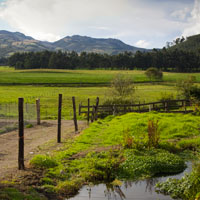According to Conservation International, Ecuador is officially ‘megadiverse’; there are 1,600 bird species, 16,000 types of plant, 106 genera of reptiles and 6,000 varieties of butterfly, for a start. Nowhere can more be seen than the famous Galapagos Islands, off the country’s Pacific coast, described as ‘a living museum and showcase of evolution’ which inspired Charles Darwin’s 1835 influential On the Origin of Species.
All this is packed into the second smallest country on the continent, thanks to Ecuador’s compact and varied geography, where Andean highlands are squeezed between Pacific coastline and the Amazonian basin. Tropical, temperate, oceanic and mountain climates exist side by side. Whether you’re climbing, diving or just beating your way through the thick jungle bush you’ll have ample opportunities to spot all manner of exotic species while simultaneously experiencing a sense of the intrepid.
When you’ve had enough of howler monkeys and tree snakes, there’s plenty of colonial heritage to explore at Cuenca and Quito. Vilcabamba, in the valley of longevity, is a great place for hiking or just enjoying a relaxing massage. Otavalo has been home to a fascinating market since pre-Inca times and today is one of the most famed spots for arts and crafts in South America. There are plenty of opportunities to try rafting, surfing, sailing, paragliding or a number of more active pursuits and the only guarantee is that no two days will be the same.
Getting there
Guayaquil and Quito both have international airports with connections across America and to Europe. There are bus connections from all the neighbouring countries and also infrequent ferries along the Rio Napo to Peru.
Getting around
The bus system is comprehensive and, given the country’s small size, very practical. Be warned however that the drivers tend to be maniacs. Domestic train and air routes are limited. Driving a car can be a challenging experience.
Local information
Language: Spanish
Time: UTC-5
Climate: Tropical monsoon. Hot throughout year, heavy summer rainfall, varies with altitude. Temperature: Max 32°C (March), Min 19°C (August). Rainfall: Max 230mm (March), Min 0mm (July-September).
Currency: US Dollar (USD)
Business etiquette: Suits are the norm. Greet with a handshake and smile; friends may greet by kissing on each cheek. This is a relationship-driven culture and third party introductions are strongly advised.
Tipping: Service charges are rarely given to the waiter; tipping 5-10% is standard.
Duty free: 300 cigarettes; 1l alcohol; A reasonable amount of perfume; gifts and personal effects to US$200;
Safety: Avoid border areas with Colombia and Peru due to the threat of terrorist activity. Protests and demonstrations are frequent and should be avoided.
Laws: Carry identification at all times. Jaywalking may incur a fine.
Healthcare: Vaccinations required for diphtheria, hepatitis A, tetanus and typhoid. Good healthcare is available in cities and there are plenty of pharmacies in urban areas. For serious illnesses, patients may be evacuated to the US Health insurance is essential and should include emergency repatriation.
Socket type: Type A, Type B





